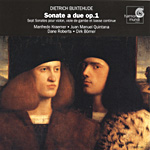Previous to this recent Harmonia Mundi release of Dietrich Buxtehude’s seven Op. 1 sonatas, the only other available complete recording on CD was on Marco Polo, performed by John Holloway, Jaap ter Linden, and Lars Ulrik Mortensen. It’s a serviceable account characterized by an overly excessive evenness of dynamics and a minimum of ornamentation (unusual for these early music vets, especially Holloway). As the first volume in Marco Polo’s complete Buxtehude Chamber Music series this effort merely seemed to fill a gap. However, this new performance by Manfredo Kraemer, Juan Manuel Quintana, Dane Roberts, and Dirk Börner provides an alternative that transcends the perfunctory–one that illustrates all of the bold invention, expression, and originality that permeates these extraordinary compositions.
As in Christophe Coin’s Ensemble Baroque de Limoges’ stunning recent performance of the Fourth sonata BuxVW 255 for Naïve (type Q4780 in Search Reviews) where a second violin is added, first violinist Manfredo Kraemer wisely enlists the aid of Dane Roberts’ second violin throughout these performances. This customary practice during the Baroque enabled the ensemble more freedom to improvise, embellish, and ornament, thus heightening the overall spirit of spontaneity and play. Unlike Coin’s rendering of the Ciaccona Vivace that begins BuxWV 255, Kraemer’s ensemble takes a more stately approach somewhat similar to Harmonia Mundi’s earlier Boston Museum Trio recording–though with an edge. Kraemer’s sprightlier tempos combined with the way he dramatically delineates the fugues propels the work, achieving a momentum that makes the Bostonians’ efforts seem hesitant if not prissy in comparison.
Equally telling is Kraemer’s inspired performance of the “unruly” Sixth sonata BuxWV 257. By his frequent notations in the score of such directions as “Con discretione” and “stylus phantasticus” (referring to the rhythmically free passages that can be played fast or slow according to the performer’s taste) Buxtehude encouraged the players to freely express whatever musical fantasies they entertained. Kraemer and colleagues couldn’t be more up for the task and they seize every opportunity to thrill. The slow, sinister bloom that begins the first movement Grave-Allegro soon evolves into raucous banter between Kraemer’s domineering violin and the rest of the ensemble–only to have the tables turned in the third movement, where the ensemble roars. Accelerating into the fourth movement, Kraemer’s virtuosic severity is a marvel, leading the charge one moment then becoming reticent the next. The final Poco presto-Poco adagio-Presto-Lento (where Buxtehude incidentally allows no indulgence) portends to unify the ensemble, though it’s treated here more as a mutual declaration of each instrument’s independence and less as a truce between them.
Throughout this recording Kraemer and his fellow performers consistently display equally remarkable sensitivity, alacrity, and attention to detail. Harmonia Mundi’s presentation and sound are first rate. Peter Wollny’s concise notes are informative and as enthusiastically attentive as the music making. In all, this is an extraordinarily inspired recital that breathes fresh life into these unjustly neglected minor masterpieces.
































